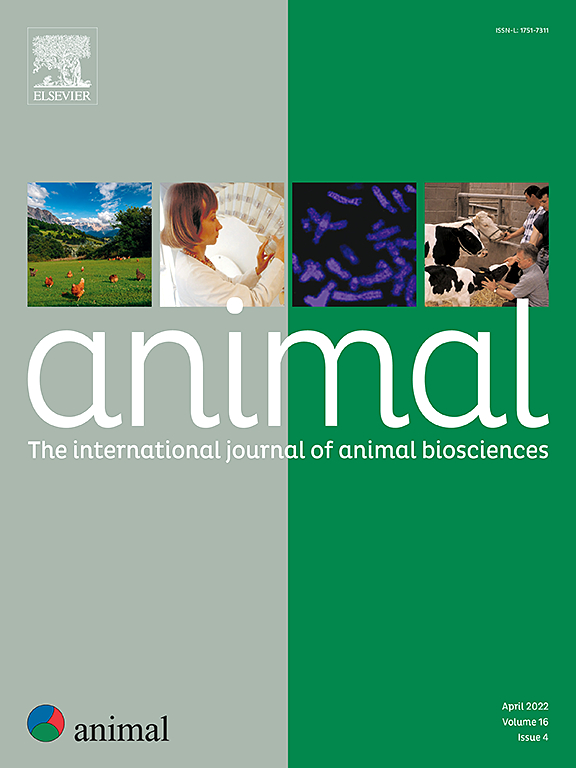Efficient pigs do not always have less environmental impacts: insights from an individual-based model to assess environmental, economic and technical performances
IF 4.2
2区 农林科学
Q1 AGRICULTURE, DAIRY & ANIMAL SCIENCE
引用次数: 0
Abstract
Pig production is facing economic and environmental challenges. In previous studies, the environmental impacts of pig farming have mainly been assessed with group-feeding strategies. A feeding strategy applied to a group of pigs results in unequal animal responses and environmental impacts due to inter-individual variability in lean growth potential and nutritional requirements. The present work aimed at fairly evaluating pigs’ responses in a given production system. We designed a methodological approach able to (i) virtually assess technical, economic and environmental performances of each fattened pig within a population; and (ii) help determine the pig characteristics resulting in contrasted environmental performances in a conventional system including feedstuffs classically used on French commercial farms. For that purpose, experimental data collected on 732 entire Large White males were used to adjust growth profiles using InraPorc® software and to estimate the amino acid (AA) requirements of pigs. Each individual profile was used to generate a virtual population of 1 000 pigs. For each population, technical performances were simulated with an individual-based model, economic and environmental evaluations were applied to these performances and then averaged to assess the individual performance of each of the 732 original pigs. Climate change, use of fossil resources, acidification, eutrophication potentials and land use impacts were evaluated per kg live BW at farm gate through life cycle assessment. A principal component analysis was applied to the correlation matrix between environmental and economic performances to identify their main drivers. Hierarchical clustering was used to group pigs with similar responses. Three clusters of pigs were distinguished. Cluster 1, with the best environmental and economic performances, combined low feed conversion ratios, relatively low-impact feeds and high protein deposition potential (PDm). Clusters 2 and 3 displayed the worst environmental performances. Cluster 3 had similar feed efficiency and economic performances as Cluster 1, but higher initial AA requirements, resulting in high-impact feeds and a lower protein deposition. Cluster 2 had the lowest-impact feeds due to the lowest initial AA requirements and were the least efficient. Feed efficiency, PDm and AA requirements of pigs at the beginning of fattening were the main factors affecting environmental performances. Contrary to previous studies where group feeding was modelled, we show that feed efficiency alone cannot be retained to identify pigs with the lowest impacts. Other pig characteristics such as AA requirements, PDm and environmental impacts should be accounted for to lower the environmental impacts of pig production.
高效猪并不总是对环境的影响更小:从基于个体的模型来评估环境、经济和技术性能的见解
生猪生产面临着经济和环境方面的挑战。在以往的研究中,猪养殖的环境影响主要是通过群体饲养策略来评估的。由于瘦肉生长潜力和营养需求的个体差异,一组猪的饲喂策略导致动物反应和环境影响不平等。目前的工作旨在公平地评估猪在给定生产系统中的反应。我们设计了一种方法方法,能够(i)虚拟评估一个种群中每头肥猪的技术、经济和环境性能;(ii)帮助确定猪的特性,从而在包括法国商业农场传统使用的饲料的传统系统中形成对比的环境性能。为此,本研究使用InraPorc®软件对732头大型公猪的生长曲线进行调整,并估算猪的氨基酸需用量。每个个体剖面被用来产生1000头猪的虚拟种群。对每个猪群,采用基于个体的模型模拟技术性能,对这些性能进行经济和环境评价,然后进行平均,以评估732头原猪的每头个体性能。通过生命周期评估,评估了气候变化、化石资源利用、酸化、富营养化潜力和土地利用对养殖场大门口每公斤活体重的影响。对环境绩效和经济绩效之间的相关矩阵进行主成分分析,以确定其主要驱动因素。采用分层聚类方法对具有相似反应的猪进行分组。区分出了三群猪。集群1具有最佳的环境和经济性能,具有较低的饲料系数、相对低的影响饲料和较高的蛋白质沉积潜力(PDm)。集群2和集群3的环境表现最差。集群3的饲料效率和经济性能与集群1相似,但初始AA需用量较高,因此饲料的影响较大,蛋白质沉积较少。由于最低的初始AA需求,集群2具有最低影响的饲料,并且效率最低。肥育初期猪的饲料效率、PDm和AA需要量是影响环境性能的主要因素。与以前的研究相反,在群体饲养模型中,我们表明,饲料效率不能单独保留来确定猪的最低影响。为降低生猪生产对环境的影响,应考虑猪的其他特性,如AA需求、PDm和环境影响。
本文章由计算机程序翻译,如有差异,请以英文原文为准。
求助全文
约1分钟内获得全文
求助全文
来源期刊

Animal
农林科学-奶制品与动物科学
CiteScore
7.50
自引率
2.80%
发文量
246
审稿时长
3 months
期刊介绍:
Editorial board
animal attracts the best research in animal biology and animal systems from across the spectrum of the agricultural, biomedical, and environmental sciences. It is the central element in an exciting collaboration between the British Society of Animal Science (BSAS), Institut National de la Recherche Agronomique (INRA) and the European Federation of Animal Science (EAAP) and represents a merging of three scientific journals: Animal Science; Animal Research; Reproduction, Nutrition, Development. animal publishes original cutting-edge research, ''hot'' topics and horizon-scanning reviews on animal-related aspects of the life sciences at the molecular, cellular, organ, whole animal and production system levels. The main subject areas include: breeding and genetics; nutrition; physiology and functional biology of systems; behaviour, health and welfare; farming systems, environmental impact and climate change; product quality, human health and well-being. Animal models and papers dealing with the integration of research between these topics and their impact on the environment and people are particularly welcome.
 求助内容:
求助内容: 应助结果提醒方式:
应助结果提醒方式:


